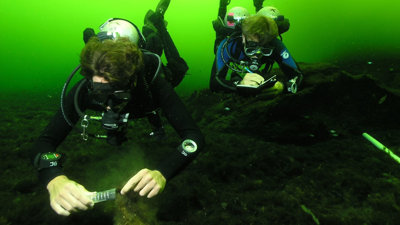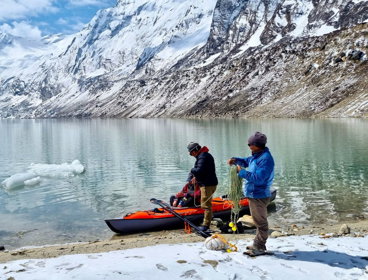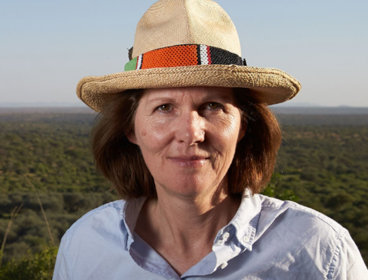Even the most worthwhile expedition plan will grind to a halt without appropriate funding. That's why knowing how to budget for an expedition is essential.
Think of your budget as more than just numbers in a spreadsheet – it's an evolving financial blueprint for your entire project. A robust and detailed budget not only keeps your planning on track; it's also the key to unlocking sources of expedition funding.
Potential donors want to see that you've done your homework, that you're organised, and that their money will be used wisely. In short, a robust budget isn't just good practice – it's your expedition's ticket to reality.
Here at the Society, questions about how to fund an expedition are some of the most frequent we receive. Indeed, we’ve been advising people on every aspect of expedition planning (as well as providing funding for expeditions and fieldwork projects) for nearly 200 years!
In this in-depth article, we’ll lay out our accumulated expertise on the topic of how to budget for an expedition in a structured and integrated manner, helping you understand what goes into building a comprehensive financial plan for your project that’ll put your aim and objectives within reach.
1. Early budget development
Drafting a preliminary budget is something any potential expedition leader should put together when beginning to develop their project. Your budget will serve as the fundamental framework for planning decisions, and working out the numbers will also give you a good indication of the viability of your expedition, or if you need to temper your expectations.
If yours is a larger budget for an expedition project with higher stakes, it will benefit from being more granular in its construction. The higher the costs, the more organisation will be required when building the budget. It could also be more difficult to gain outside financial support when the numbers are larger, so having everything clearly laid out and justified is essential.
2. Budget evolution and adaptation
As the planning for your expedition takes shape, your budget will also develop. Consider it a dynamic document that should be regularly updated and refined as more pieces of the plan come together. Constantly import new information regarding costs, sources of finance, and other relevant matters as you go along. Leaving these matters until later will make your job far more arduous. The approach of regular updates on a small scale will make your life a lot easier.
Ensure your budget is realistic. You’ll often need to compromise between lofty ambitions and available resources, particularly in the early stages of your expedition career. If you don’t have a proven track record of successful expeditions on your CV, you will have a much larger challenge to secure funding from outside sources. A detailed budget will also demonstrate your understanding of the full scale of your project both to yourself and your potential supporters. This will add to your credibility and ability to raise financial support.
An important factor to be aware of is that funding organisations may and do impose restrictions on how their funds can be spent, so you will need to moderate what types of expenses are permissible, and in what proportion to the overall budget. As a result, you should be as accurate as possible when putting together your budget and submitting it as part of a proposal to a potential supporter.
3. Classifying expenditure: fixed vs. adjustable costs
Your initial budget should include all the basic financial components of your expedition, before, during and after the project.
One fundamental aspect of your expedition budget will be differentiating between the fixed and adjustable costs associated with your expenditure items.
Fixed costs
Start with the inescapable ‘Fixed costs’. Fixed costs are those that are unavoidable and relatively inflexible. If you are required to adjust these, it will often necessitate significant changes to the expedition's overall plan.
Fixed costs categories might include
- International airfares
- Visas and research permits
- Travel insurance (medical, evacuation)
- Essential scientific equipment and maps
- Safety equipment and communications
Adjustable costs
Adjustable costs are those that have a certain degree of flexibility and are more likely to limit the expedition's scope, efficiency and comfort level.
Adjustable cost categories might include
- Food and catering
- Accommodation
- Equipment purchases or rentals
- Training costs
- Medical kit
Whilst these costs are adjustable, they should of course not be adjusted to the detriment of the safety and well-being of the expedition and its team members.
4. Financial oversight and responsibility
When putting together your expedition team and defining a budget, one of the first things you should do is assign the role of designated treasurer. This person will be responsible for managing and overseeing all financial matters, so the sooner this person can take on this role, the easier and more organised this job will be.
The treasurer should also be the person who is comfortable with informing the expedition leader if the budget is no longer viable in its planned form. At that point, it would be the time to investigate the possibility of adjustments to existing costs or whether further finances can be raised from outside sources or through personal contributions to the team.
Ultimately, it is the responsibility of the whole team to contribute to the upkeep of the financial statement about the expedition, whether it’s from personal fundraising income, equipment purchases, or any other costs. All should be quickly reported to the treasurer to ensure transparency and accurate record keeping.
5. Budgeting tools and techniques
Spreadsheet software such as Excel, Numbers, Google Sheets, or OpenOffice is the most popular and efficient method of keeping track of a detailed budget and provides the opportunity for analysis.
With these tools, you can easily create separate sheets for different budget categories such as travel expenses, equipment purchases, and research costs. You can also set your limits for these expenses and track how close you are to them.
Purpose-designed budgeting apps and software make building a budget and tracking your ongoing expenses very simple. This can be useful both during the planning stage of your expedition as well as when you are in the field. Many of these apps are also shareable with others so you can give access to your team members to enter their expenses in real time.
6. Financial decision-making and alternatives
When putting together your budget, it is essential to establish financial cut-off points to guide decision-making and prevent overspending. This is especially important if you are running a smaller expedition budget or it is your first expedition, as finances are likely to be a lot more limited. You should consider your ability to raise extra funds in the event of overspending. If you cannot raise further funds, then you will need to adjust your project plans.
7. Accounting for economic factors
The potential for inflation rate fluctuations when embarking on international expeditions can make a significant difference when projecting your costs. Expedition plans from conception to when you and your team go into the field can take years in the making. Any manner of costs can change significantly in that timeframe – and the change is more likely to be a price increase than a decrease. In countries where inflation and/or currency exchange rates fluctuate significantly, you will need to take this into account.
It is important to consider how to access funds when you are in the field. You will need to factor in the cost of withdrawing funds from local banks and ATMs, or if you are even able to use them. Your access to funds could be limited to using international transfer services such as Western Union, which will come with their own costs and restrictions.
8. Budgeting for local participation
When putting together your budget, ensure that you have included any costs associated with participants from the host country. Again, transparency is important, and clarity around the costs local participants will be expected to pay, and what may or may not be subsidised by the expedition, should be agreed in advance.
You may be employing guides, porters, fixers, or other local experts to assist your project, and they may need to be provided with stipends, potential wages, accommodation, extra training, and equipment. These all need to be accounted for and budgeted ahead of time.
9. Income and expenditure estimation
Given that you will be creating a budget ahead of time and thus you won’t know the exact cost of the expenses that your project will incur, it is essential to provide estimates for both maximum and minimum potential expenditures. This will provide an average range for your potential funders and your teammates to access and make decisions on the financial viability of your expedition.
10. Financial management best practices
The importance of meticulous management of incoming funds and outgoing expenditures is essential and cannot be overstated. Unless you are entirely self-funded, you will have many stakeholders to whom you are accountable, and as such, you will need to have all financial statements available upon request.
Inadequate budget management, especially those related to your larger expenses such as underestimating the cost of travel, can have a major effect on your expedition and could result in project delays or cancellation.
11. Contingency planning
A contingency fund to address unforeseen expenses or emergencies is an essential component of your expedition budget. Incidents occur, local unrest can flare up, team members can fall ill or have an accident, all of which should be covered in your risk assessment.
These potential expenses will need to be considered and accounted for. Whilst in some circumstances your expedition insurance will provide coverage for these issues, often your team will be required to pay upfront, thus you will need to be able to afford this initial outlay.
It is recommended that a specific percentage (e.g., 20-30%) of the total budget should be allocated to the contingency fund.
Beyond the budget: next steps
Once you’ve completed your first draft of your expedition budget, it’s time to take a step back and reassess. Ask yourself: does your budget accurately reflect the full scope of the project? Is the total budget realistically within my team’s ability to raise? If not, are there ways to reduce costs or adjust the project’s scope?
There are regularly overlooked aspects of an expedition that you will need to ensure you’ve budgeted for. Often, after the expedition is wrapped, you will need to report back your findings or put together content for funders. The costs associated with reporting and communicating what you have achieved will all need budgeting for in the planning stage.
Pass your budget draft around your team. They will have insight into potential aspects of your finances that may have been overlooked.
Ultimately, your aim will be to have a thorough and robust budget assembled prior to your first approach to potential funders. Doing this will give you a head start in making your expedition project a reality.
Stay updated
Be the first to hear when new resources are launched by subscribing to our monthly exploration community newsletter. You'll also receive relevant news and events from the Society.
- You will be asked to create a free Society account if you haven't already done so.
- Once logged in, navigate to My preferences and select News and events about fieldwork and expeditions.





